Grotta Nuova
Grotta Nuova di Villanova
Useful Information
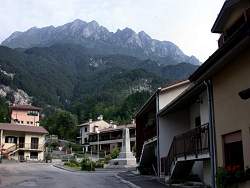

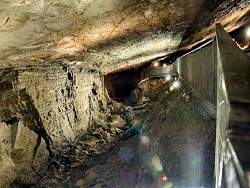
| Location: |
Fraz. Villanova delle Grotte 3, 33010 Lusevera UD.
28 km from Udine, 9 km from Tarcento. Autostrada A23 exit Udine Nord-Gemona. Follow Strada Statale 13 Pontebbana about 20 km to Tarcento, Alta Val Torre, Lusevera. When the Val Torre narrows to a gorge turn right to Villanova. Signposted. (46.257858333333330, 13.28226111111111) |
| Open: |
JUN to 24-JUL Sat, Sun 15:30. 25-JUL to 11-SEP Mon-Thu 14, Fri 15:30, Sat, Sun 12, 15:30. 12-SEP to SEP Sat, Sun 12, 15:30. OCT to NOV Sun 12, 15:30. Special Sala Regina Margherita: JUN to 24-JUL Sat, Sun 10:30, 14. 25-JUL to 11-SEP Mon-Thu 10:30, Fri-Sun 10:30, 14. 12-SEP to SEP Sat, Sun 10:30, 14. OCT to NOV Sun 10:30, 14. [2022] |
| Fee: |
Adults EUR 10, Children (6-12) EUR 8, Children (0-5) free, Students (-26) EUR 8, Seniors (65+) EUR 8, Disabled EUR 8. Special Sala Regina Margherita: Adults EUR 18, Children (6-12) EUR 14, Seniors (65+) EUR 14. Groups (15+): Adults EUR 16. [2022] |
| Classification: |
 Karst Cave Karst Cave
|
| Light: |
 Incandescent Incandescent
|
| Dimension: | L=8,020 m, VR=296 m, T=11 °C. |
| Guided tours: |
D=90 min, St=1,000, A=565 m asl. Special Sala Regina Margherita: D=2.5 h. |
| Photography: | allowed |
| Accessibility: | no |
| Bibliography: | |
| Address: |
Gruppo Esploratori e Lavoratori Grotte di Villanova, Villanova delle Grotte N°3, 33010 Lusevera (UD), Tel: +39-0432787915.
E-mail: Cave Trekking tours: Braida Lucia, Tel: +39-03332389687, Tel: +39-03921306550. E-mail: |
| As far as we know this information was accurate when it was published (see years in brackets), but may have changed since then. Please check rates and details directly with the companies in question if you need more recent info. |
|
History
| 1925 | discovered by Pietro Negro from Villanova, developed and opened to the public. |
| 1984 | new entrance inaugurated. |
Description
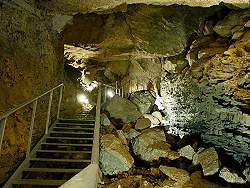
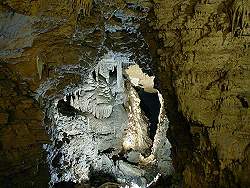

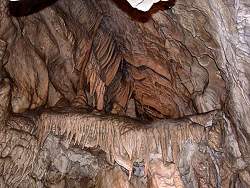
Grotta Nuova di Villanova is not very well known, as it is located in a really remote place. To reach this place you have to drive into Alta Val Torre (Upper river Torre valley) and then cope with the steep ascend to the village Villanova. The cave is located below the village, with a parking lot and a nice café.
Apropos new, the term new is repeated so often, that it is hard to determine what is meant. The village is called Villanova, which means new town, obviously founded by people from an old town. They discovered various caves, and one which was actually named Grotta Doviza became known as Grotta di Villanova. But when they found a new cave in 1925, they called it Grotta Nuova, the new cave. And that’s why it is named New Cave of New Town. The Slovenian name is much less funny, it is Zavarske Jama.
The natural entrance in the village named Zaiama, the upper part of Villanova, is a 22 m deep pothole, on a prominent place, right in the middle of the town. It was opened to the public almost immediately, with paths and an artificial entrance tunnel, and visited for almost 60 years. The entrance was comfortable, though with numerous steps, but the upper part of the cave is sometimes quite narrow or low, and tour was a little difficult and visitors became wet and dirty. The cavers explored and surveyed the cave, and they found a part with beautiful and much larger passages in the middle part of the cave. So they planned to access the cave in the middle with another tunnel and develop the lower part of the cave system from this new entrance. So this is now the New Entrance of New Cave of New Town. Pretty funny if you think about it.
The entrance located near Villanuova, just follow the main road and keep left. The road to the right leads steep uphill to Zaiama, but there is nothing to see, the natural entrance is filled in and the artificial is closed. After a few hundred meter the parking lot is reached, with a nice café which is open on open days of the cave. On the opposite side a single lane road leads down to the cave entrance far below the village. This road was built for the heavy machinery to dig the tunnel, but visitors have to park at the parking lot and walk down, its only 300 m but a descent of more than 50 m. The ticket office is located at the end of the road right beneath the new cave entrance. And if you think that’s the end of the descent, you are wrong. Inside the cave there are many more staircases, starting with the long staircase in the steep artificial entrance tunnel.
The cave is entered at a huge chamber with a small artificial lake. Here two main passages branch off, to the right and the left. First we follow the right one, which leads further down.
This part of the cave shows almost no speleothems, but still it is the most impressive and most interesting part of the whole cave. It shows a cave developed in flysch, which is composed of marls. Karst caves are formed by the solution of limestone, but this cave is formed inside a water-resistant and not soluble rock. The explanation of this enigma is pretty easy: the impermeable rock dammed the groundwater inside the rock. The groundwater collected on this layer, a so-called hanging groundwater body, and flew downhill on top of the impermeable rocks, but in cracks inside the soluble rock above.
Flowing on top of the flysh it formed a karst cave by dissolution. But once a small cave passage had formed, the water flew inside the passage like a river, and erosion, the mechanical destruction of rock, started. The water has a certain energy from flowing downwards, which is multiplied by the abrasive effect of sand and small stones which it transports. This process is not restricted to soluble rocks, solution is not necessary. The impermeable marl is rather soft and so it is subject to really fast erosion.
This part of the cave has a really characteristic shape: huge passages and chambers with an extremely flat ceiling. This ceiling is formed by the lowest layer of the limestone. We are in the Southern Limestone Alps, the rocks have been moved by strong tectonic forces during the orogeny of the Alps, and so the limestone is tilted by approximately 35°. The ceiling shows some cracks and solution forms, socalled anastomosis, which is the start of every karst cave. But the cave is almost completely formed inside the soft marl by erosion. The walls show a crossection through soft, thin bedded sedimentary rocks with a high content of clay.
The tourist path is built on a metal framework, and it is very comfortable. Still the path follows the path of the water, straight downhill, and so the descent to the end of this passage is about 60 m. And at the end we have to go up the same way again.
Back at the entrance hall, we now take the other direction. This passage is completely different, it is not huge, it is not tilted, and it is more or less horizontal. This part of the cave is formed entirely inside limestone, and thus has a completely different morphology. Narrow and high gorges run snakelike through massive rock with little clefts and no bedding. At the end of this now dry river passage lies a labyrinth of small passages and chambers, filled with speleothems. Some side passages show steps cut into the floor, a remains of the old show cave, developed from the city center above. This was once the lower end of the tour from the other side.
Again we have to return to the entrance hall and now leave the cave through the tunnel. All in all there is an enormous height difference, both to reach the cave entrance and then inside the cave. Although the path is very well developed and definitely not difficult, we would advise people with medical problems like heart disease or respiration problems, to think about not visiting the cave.
On the other hand, if you are physically fit and a 1.5 hour tour is not enough to satisfy your interest, we recommend the Special Sala Regina Margherita tour. This tour takes 2.5 hours,
- See also
 Search DuckDuckGo for "Grotta Nuova di Villanova"
Search DuckDuckGo for "Grotta Nuova di Villanova" Google Earth Placemark
Google Earth Placemark OpenStreetMap
OpenStreetMap Grotta Nuova di Villanova, official site. (
Grotta Nuova di Villanova, official site. ( )
) Grotta Nuova di Villanova, AltaValTorre.Com - Il Portale della Valle del Torre (
Grotta Nuova di Villanova, AltaValTorre.Com - Il Portale della Valle del Torre ( )
) AdriaticoWeb.com, picture gallery of cave trekking tours.
AdriaticoWeb.com, picture gallery of cave trekking tours. Les sites geotouristiques des alpes - Grotte de Villanova (
Les sites geotouristiques des alpes - Grotte de Villanova ( )
)
 Index
Index Topics
Topics Hierarchical
Hierarchical Countries
Countries Maps
Maps